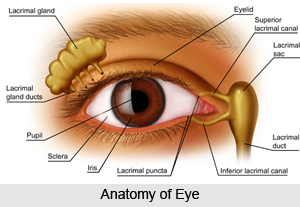 Eye diagnosis in Ayurveda plays a significant role in determining the disorders and overall physical health of a person and consequently helps in applying the appropriate healing technique. Various features such as colour and shape of eyes, orientation of eyelids and type of eyelashes aptly reflects the problems associated with particular organs of the body. It also reveals the basic constitution of the body of an individual. An individual having Vata constitution has small and nervous eyes along with dry scanty lashes and drooping eyelids. The white of such eyes is muddy and the iris is dark having black or grey-brown colour. The eyes of a person having Pitta constitution have moderate size and are lustrous, sharp and sensitive to light. Such eyes have scanty and oily lashes with red or yellowish iris. The white of Pitta eyes often have reddened whites, having a tendency of acquiring nearsightedness.
Eye diagnosis in Ayurveda plays a significant role in determining the disorders and overall physical health of a person and consequently helps in applying the appropriate healing technique. Various features such as colour and shape of eyes, orientation of eyelids and type of eyelashes aptly reflects the problems associated with particular organs of the body. It also reveals the basic constitution of the body of an individual. An individual having Vata constitution has small and nervous eyes along with dry scanty lashes and drooping eyelids. The white of such eyes is muddy and the iris is dark having black or grey-brown colour. The eyes of a person having Pitta constitution have moderate size and are lustrous, sharp and sensitive to light. Such eyes have scanty and oily lashes with red or yellowish iris. The white of Pitta eyes often have reddened whites, having a tendency of acquiring nearsightedness.
Large, moist and beautiful eyes are indicative of Kapha constitution. The lashes of such eyes are oily, thick and long. The iris is usually pale having blue or black colour whereas the white of the eyes is extremely white. A drooping upper eyelid signifies deranged Vata, lack of confidence, fear and sense of insecurity. The concept of Ayurveda states that the energy is derived by the eyes from the basic fire element. The sensitivity of an eye towards light is due to the fiery energy in the retina. Individuals having Pitta constitution have abundance of fire in the body which often results in hypersensitivity to light. In case the conjunctiva of the eye is pale it represents anaemia and its yellow colour signifies weak liver.
Examination of shape, size and colour of the eye is also very crucial. Small iris of the eye is indicative of weak joints whereas a white ring around it represents excessive intake of sugar and salt. This may also be indicative of bodily stress in middle aged people. In case the white ring is too white and prominent, especially in the middle aged people, degeneration of joints may be inferred. In such situations popping and cracking of joints, arthritis or joint pains are common. Iris having brownish-black spots signifies unabsorbed iron in the intestine.




















